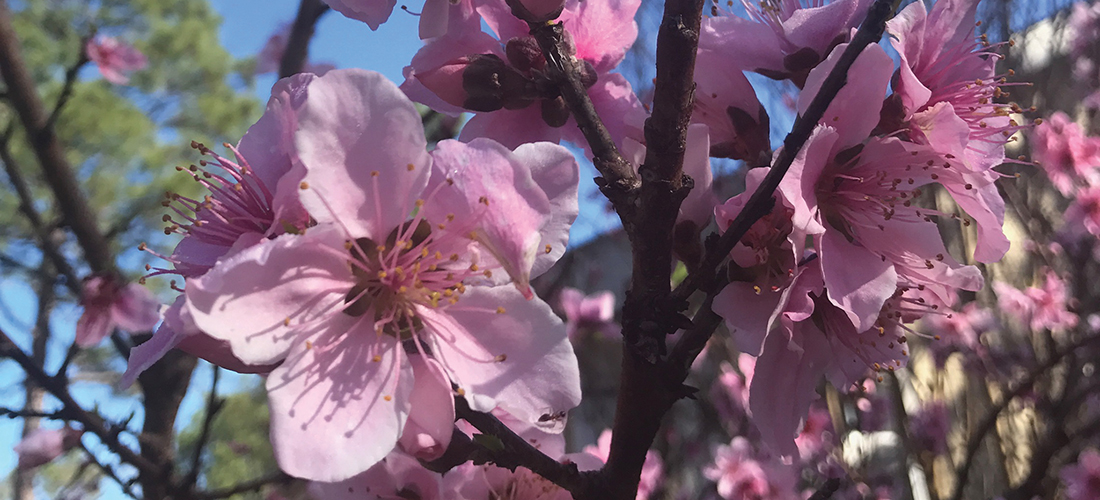
Waiting for the other shoe (and temperature) to drop — as April comes (way) early to the Sandhills
By Jan Leitschuh
Are you a betting man, or woman, as the case may be?
Though no psychic, I predict we’re in for a bruising from the weather. I’m not happy about those odds, and only hope it’s “not that bad.”
My speculation is based on long observation of the land and the weather here. Along with the profound, gut-level understanding that Sandhills strawberries and peaches are unique things, veritable sweet ambassadors for this marvelous region.
By now, you’ll know if I was right or wrong. Maybe. You’ll possibly have me at a disadvantage. Or not. As I write, it’s near the end of an unusually warm February. You’re reading this in April. By now, what’s happening will have happened.
So. Here’s the thing. My peaches are in full bloom on Feb. 22. Not all varieties, but the majority of the peach trees here are blowsy with bees and stunningly gorgeous, sheathed as they are in salmon-pink loveliness. My spring-craving soul rejoices in this gift, photographing the blossoms from all angles, in all light.
But the gardener in me — as well as the produce coordinator in me (for Sandhills Farm to Table Co-op, a community-supported produce box distributing organization) — says, “Yikes!”
“I love this warm weather,” a friend confided in me today, which topped out at 78 degrees. “But it’s so unsettling because it’s so unusual. It’s spooky. Plants can’t go inside and sit in the air conditioning.”
A February headline in the Washington Post said, “Fast-Forward Spring; February’s Warmth is Extreme, And It’s Just Getting Started.” This month, the temperature has averaged at least five degrees above normal over the lower 48. It’s April-in-February.
But it’s not April . . .
The USA National Phenology Network tracks spring’s arrival by reporting on the timing of leaf-out, flowering and other phenomena. According to this group, plant spring came in February this year: “Spring has arrived three weeks early in Virginia and Kentucky . . . continuing a pattern we see across the Southeast.”
Our average last frost date for the Sandhills is typically around April 9. It’s been earlier in recent years.
But when have we ever had a last frost date in February?
I’ll spare you the looking: Never.
That means those fragile pink blossoms, those happy pollinators, the potential young fruit are all vulnerable to a hard March freeze. No young fruit? No Sandhills peaches. Not a happy thought. As one of my peach-farming friends told me, “I’ve had peaches in full bloom once on Feb. 26 and still made a good crop. But only once. It’s not really looking good for the home team right now.”
The good news is that peach trees, as a rule, are exuberant lovelies. They throw off far more blossoms, and set far more fruit, than is needed for a decent crop. I’ve heard peach farmers say that even with only 17-18 percent of a crop left undamaged in an orchard, a grower can still manage enough bank to keep the farm alive another year. Most years, they have to thin the fruit. How likely this year? Unknown territory.
We’ll have a freeze. I’d bet those odds. But how bad?
If the freeze is not too hard, say 27 degrees, or perhaps even down to 26, producers bring various helpful mechanisms to bear. You may remember old photos of smudge fires and tires being burned; those days are gone. Today farmers harness the wind, using machines that mix the ground’s rising warm air with the descending frost. It only changes the temperature at tree level by a few degrees, but often that’s all that’s needed to keep delicate cells from freezing and bursting.
Others use clever site selection to overcome frost pockets, since the heavier cold air rolls downhill and pools at the base of slopes.
One last bit of good news. Despite the warm winter, experts say there have been just about enough chill hours — that is, degree-hours below 45, basically — that the peach trees can make fruit, should the weather gods allow. The lowest-chill-hour varieties are the earliest, at about 550-600 hours. The early clingstone Rich May is at 650 hours. The North Carolina varieties like Derby, and Windblo and Candor are in the 800 to 1,000-hour range. According to one of my peach growers, his site has accumulated 1,080 chill hours this year. The wildly popular freestone Contender, China Pearl and Carolina Gold all clock in at 1,100 chill hours. “We’ll see, but I think we’ll be OK there,” he says. “So, as far as chill accumulation, we’ve pretty much jumped through that hoop.”
But not a hard freeze.
Me, I watch the weather and get out my extra blankets in the late afternoon, before the heat is entirely gone, and swaddle my little babies. Sometimes it works, sometimes it doesn’t. But I don’t have to bet the farm on them.
I mention peaches, but the same issues affect other fruit crops, such as strawberries, plums, blueberries, and later blackberries, figs and apples.
Strawberries are big around here. Local families adore visiting pick-your-own fields, snacking on the tender and juicy Sandhills strawberries, bred for taste and sweetness rather than the ability to be picked half-ripe and shipped across the country without going bad. So, yes, your Sandhills strawberries need to be eaten quickly. But that fresh flavor . . .
As of February, the plants are already blossoming and setting fruit. It’s unlikely these blossoms and set fruits will survive a hard frost. If each plant only has so many arrows in its quiver, a few are being loosed now, reducing spring yields.
Strawberry farmers are used to dealing with frosts, and receive daily frost bulletins from strawberry specialists watching the weather. You may have seen long, white strips of fabric in farm fields — these are spun poly covers that deter a few degrees of frost. Again, they can survive an easy frost. But 17 degrees would bring a big hammer down on the area.
And here’s the “maybe” part. Depending on when you’re reading this in April, we may not be out of the frosty woods yet. So, you may still be in the same boat as me — wondering, hoping. Salivating.
“I worry about the last week in March and the first week of April more than anything,” said one orchardist. Another mentioned the hard April 10 freeze last year that cut deeply into his crop. Some hard and dangerous freezes have been even later. “All the worst freezes I’ve ever had have been in April,” said that grower.
So, we know we love our local farmers. Many of them have become familiar faces, the neighbors we buy our food from. We know the value of circulating money within the local economy. We love the green space of farms clustering around our little towns. So here’s the question, or rather two questions:
If the worst happens, and only a small crop is harvested, are you going to support it even if the prices rise to reflect the scarcity?
And, the bigger of the two:
How many seasons can a producer lose a crop and survive?
Think about it. If we value our local producers, if we value the flavor, green space and economic boost that comes with having fantastic fresh produce-growing experts in our community, how are we going to show it?
Are we going to pull out our wallets and subscribe to the farmer’s co-op, Sandhills Farm to Table? Will we visit their farm stands? Will we go to the farmers markets, and pay the prices without giving the producers a hard time?
If I were a betting person, I’d take those odds. I’d back local. PS
Jan Leitschuh is a local gardener, avid eater of fresh produce and co-founder of the Sandhills Farm to Table Cooperative.





